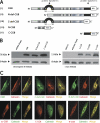C-terminal domain of chromogranin B regulates intracellular calcium signaling
- PMID: 22016391
- PMCID: PMC3247949
- DOI: 10.1074/jbc.M111.251330
C-terminal domain of chromogranin B regulates intracellular calcium signaling
Abstract
The versatility of intracellular calcium as a second messenger is seen in its ability to mediate opposing events such as neuronal cell growth and apoptosis. A leading hypothesis used to explain how calcium regulates such divergent signaling pathways is that molecules responsible for maintaining calcium homeostasis have multiple roles. For example, chromogranin B (CGB), a calcium binding protein found in secretory granules and in the lumen of the endoplasmic reticulum, buffers calcium and also binds to and amplifies the activity of the inositol 1,4,5-trisphosphate receptor (InsP(3)R). Previous studies have identified two conserved domains of CGB, an N-terminal domain (N-CGB) and a C-terminal domain (C-CGB). N-CGB binds to the third intraluminal loop of the InsP(3)R and inhibits binding of full-length CGB. This displacement of CGB decreases InsP(3)R-dependent calcium release and alters normal signaling patterns. In the present study, we further characterized the role of N-CGB and identified roles for C-CGB. The effect of N-CGB on calcium release depended upon endogenous levels of cellular CGB, whereas the regulatory effect of C-CGB was apparent regardless of endogenous levels of CGB. When either full-length CGB or C-CGB was expressed in cells, calcium transients were increased. Additionally, the calcium signal initiation site was altered upon C-CGB expression in neuronally differentiated PC12 and SHSY5Y cells. These results show that CGB has numerous regulatory roles and that CGB is a critical component in modulating InsP(3)R-dependent calcium signaling.
Figures





References
-
- Huh Y. H., Jeon S. H., Yoo J. A., Park S. Y., Yoo S. H. (2005) Biochemistry 44, 6122–6132 - PubMed
-
- Thrower E. C., Park H. Y., So S. H., Yoo S. H., Ehrlich B. E. (2002) J. Biol. Chem. 277, 15801–15806 - PubMed
-
- Thrower E. C., Choe C. U., So S. H., Jeon S. H., Ehrlich B. E., Yoo S. H. (2003) J. Biol. Chem. 278, 49699–49706 - PubMed
-
- Choe C. U., Harrison K. D., Grant W., Ehrlich B. E. (2004) J. Biol. Chem. 279, 35551–35556 - PubMed
Publication types
MeSH terms
Substances
Grants and funding
LinkOut - more resources
Full Text Sources
Molecular Biology Databases
Research Materials
Miscellaneous

